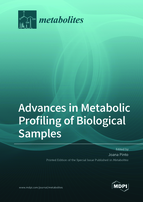Advances in Metabolic Profiling of Biological Samples
A special issue of Metabolites (ISSN 2218-1989). This special issue belongs to the section "Metabolomic Profiling Technology".
Deadline for manuscript submissions: closed (31 December 2022) | Viewed by 24849
Special Issue Editor
2. UCIBIO—Applied Molecular Biosciences Unit, Laboratory of Toxicology, Faculty of Pharmacy, University of Porto, 4050-313 Porto, Portugal
Interests: targeted and untargeted metabolomics; GC-MS; NMR; biomarker discovery; cancer
Special Issues, Collections and Topics in MDPI journals
Special Issue Information
Dear Colleagues,
Metabolomics has been a powerful approach for studying the low-molecular weight metabolites and their interactions within a biological system in a wide range of research fields (e.g., clinical and biomedical research, toxicology, microbiology, nutrition, environment). The biological samples analysed include blood serum/plasma, urine, tissues, cells, saliva, cerebrospinal fluid, and feces, among others. Due to the chemical diversity and concentration range of all metabolites present in biological samples, there are still several challenges from sample collection to metabolite annotation that need to be addressed. This Special Issue of Metabolites is dedicated to reviews and original articles covering the current methodological and technological advancements on the pre-analytical handling of biological samples, sample preparation protocols, analytical approaches for untargeted and targeted metabolic profiling, data quality assessment in large-scale metabolomics studies, and data processing and metabolite annotation tools. Manuscripts dealing with current methodological and technological advancements on metabolomics branches (e.g., lipidomics, volatilomics, fluxomics) and other challenging issues are also highly desired.
Dr. Joana Pinto
Guest Editor
Manuscript Submission Information
Manuscripts should be submitted online at www.mdpi.com by registering and logging in to this website. Once you are registered, click here to go to the submission form. Manuscripts can be submitted until the deadline. All submissions that pass pre-check are peer-reviewed. Accepted papers will be published continuously in the journal (as soon as accepted) and will be listed together on the special issue website. Research articles, review articles as well as short communications are invited. For planned papers, a title and short abstract (about 100 words) can be sent to the Editorial Office for announcement on this website.
Submitted manuscripts should not have been published previously, nor be under consideration for publication elsewhere (except conference proceedings papers). All manuscripts are thoroughly refereed through a single-blind peer-review process. A guide for authors and other relevant information for submission of manuscripts is available on the Instructions for Authors page. Metabolites is an international peer-reviewed open access monthly journal published by MDPI.
Please visit the Instructions for Authors page before submitting a manuscript. The Article Processing Charge (APC) for publication in this open access journal is 2700 CHF (Swiss Francs). Submitted papers should be well formatted and use good English. Authors may use MDPI's English editing service prior to publication or during author revisions.
Keywords
- metabolomics
- lipidomics
- volatilomics
- fluxomics
- biological samples
- pre-analytical handling
- sample preparation techniques
- analytical approaches
- data processing
- metabolite annotation







